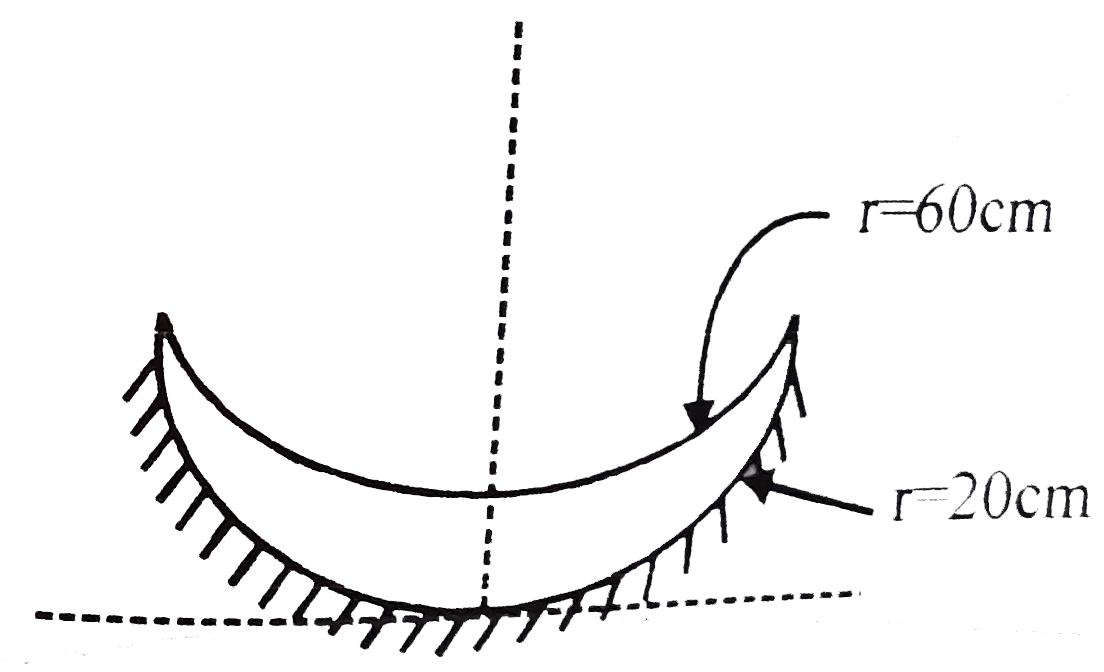The convex surface of a thin concave-convex lens of glass of refractive index 1.5 has a radius of curvature 20 cm. The concave surface has a radius of curvature 60 cm. The convex side is silvered and placed on a horizontal surface as shown in figure. (a) Where should a pin be placed on the axis so that its image is formed at the same place ? (b) If the concave part is filled with water (mu = 4/3), find the distance through which the pin should be moved so that the image of the pin again coincides with the pin.

Δx=1.15cm,up
Δx=3.15cm,down
Δx=0.05cm,up
Δx=0.15cm,down
The correct Answer is:a.
Method 1: When the concave part is filled with water of refractive index 4/3 , the optical arrangement is equivalent ot concave mirror of focal length F such that
1F=1fw+1fg+1fm+1fg+1fw
1fw=(43−1)(160−1∞)=1180
fw=180cm
fg=60cm (calculated earlier)
1F=1180+160+110+160+1180=26180
F+18026cm
X1=R=2F=18026×2=18013=13.85cm
Δx=15.0−13.85=1.15cm
Method2: We use the equation
n2x2−n1x1=n2−n1R
For refraction at the interface '1' (air water),
4/3x2−1x1=4/3−1∞ (i)
The image of interface '1' is the object foro the interface '2'.
1.5+20−1x1=1.5−4/3+60
X1=36026=13.85
ΔX=15.0−13.85=1.15cm
Method 3: Using lensmaker's formula and the relation
1F=1x2−1x1
fm=180cm (using lensmaker's formula)
fg=60cm (using lensmarker's formula)
1−180=1x2−1x1 (for the water lens) (i)
1−60=1+20−1x1 (for the glass lens) (ii)
(The image by the water by the glass lens is at +20, then the rays will fall normally on the mirrorgt)
Adding Eqs. (i) and (ii),
1−180+1−60=120−1x1
x1=18013=13.85cm
Δx=15.0−13.85=1.15cm
Topper's Solved these Questions
- BOOK - CENGAGE PHYSICSCHAPTER - GEOMETRICAL OPTICSEXERCISE - Integer15videos
GEOMETRICAL OPTICS
- BOOK - CENGAGE PHYSICSCHAPTER - GEOMETRICAL OPTICSEXERCISE - Archives7videos
GEOMETRICAL OPTICS
- BOOK - CENGAGE PHYSICSCHAPTER - GEOMETRICAL OPTICSEXERCISE - Assertion-Reasoninig2videos
GEOMETRICAL OPTICS
- BOOK - CENGAGE PHYSICSCHAPTER - FRICTIONEXERCISE - QUESTION BANK1videos
FRICTION
- BOOK - CENGAGE PHYSICSCHAPTER - GRAVITATIONEXERCISE - Question Bank39videos
GRAVITATION
Similar Questions
The convex surface of a thin concavo-convex lens of glass of R.l. 1.5 has a radius of curvature 20 cm. The concave surface has a radius of curvature 60 cm. The convex side is silvered and placed horizontally.
Q Where should a pin be placed on the axis such that its image is formed on the same point. View Solution
View SolutionThe convex surface of a thin concavo-convex lens of glass of R.l. 1.5 has a radius of curvature 20 cm. The concave surface has a radius of curvature 60 cm. The convex side is silvered and placed horizontally.
Q If the concave part is filled with water of refractive index 4/3, find the distance through which the pin should be moved so that the image of the pin again coincides with the pin?
 View Solution
View Solution
Knowledge Check
- Question 1 - Select One
The convex surface of a thin concaveo-convex lens of glass of refractive index 1.5 has a radius of curvature 20cm. The concave surface has a radius of curvature 60cm. The convex sidei is silvered and placed on a horizontal surface.

Q. Where should a pin be placed on the optice axis such that its image is formed at the same place?Ax=5cmBx=20cmCx=15cmDx=25cm - Question 2 - Select One
The concave surface of a thin concavo -convex lens of glass of refractive index1.5has a radius of curvature of 20cm.The concave surface has a radius of curvature of 60cm.The covnex side is silvered and placed on a horizontal surface as shown in the figure.

The combination behaves likeAA concave mirrorBa convex mirrorCa concave mirrorDa convex lens - Question 3 - Select One
The concave surface of a thin concavo -convex lens of glass of refractive index1.5has a radius of curvature of 20cm.The concave surface has a radius of curvature of 60cm.The covnex side is silvered and placed on a horizontal surface as shown in the figure.

The focal length of the combibnation has the magnitude.A15cmB8.6cmC7.5cmD1.5cm
The concave surface of a thin concavo -convex lens of glass of refractive index1.5has a radius of curvature of 20cm.The concave surface has a radius of curvature of 60cm.The covnex side is silvered and placed on a horizontal surface as shown in the figure.

A small object is placed on the principal axis of the combination,at a distance of 30cmin front of the mirror.The magnification of the image isView SolutionA plano-convex lens is made of glass of refractive index 1.5. the radius of curvature of its convex surface is R. its focal length is
View SolutionA plano-convex lens is made of glass of refractive index 1.5. The radius of curvature of its convex surface is R. Its focal length is
View SolutionA plano convex lens is made of glass of refractive index 1.5. The radius of curvature of its convex surface is R. Its focal length is
View SolutionThe concave surface of a thin concavo-convex lens of index1.5has radius of curvature 50cm and10cm respectively.The concave side is silvered andplaced on a horizontal surface as shown

The object distance at which its image coincides with itself isView Solution

